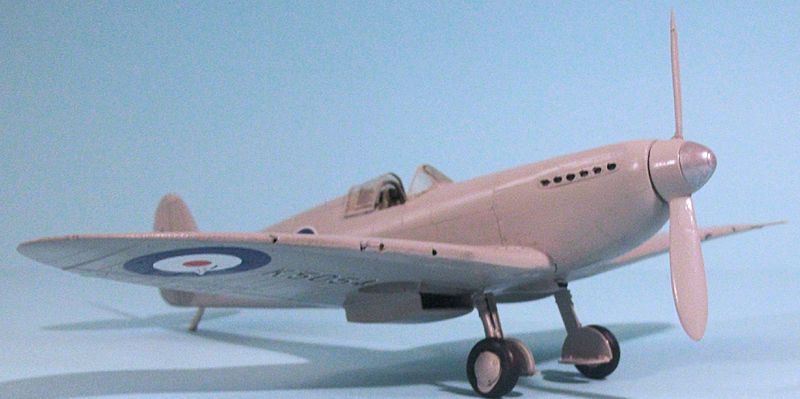
Tamiya 1/48 Supermarine Type 300 (conversion)
| KIT #: | |
| PRICE: | |
| DECALS: | |
| REVIEWER: | Tom Cleaver |
| NOTES: | Paragon conversion |

| HISTORY |
Following the failure of the F7/30 Type 224 fighter, Vickers-Supermarine
Chief Designer R.J. Mitchell determined to design what he believed would be
the answer to the need of a short-range high speed intercepter. When the
design was submitted to the Air Ministry in July 1934, it was rejected for
being too radical.
Mitchell then revised the design and in November 1934 convinced the
Board of Directors of Vickers to fund construction of the project as a
private venture. Freed of the obtuseness of official specifications, he had
created the most modern fighter design then in existence, to be powered by
the new Rolls-Royce PV-XII V-12 engine, later named the "Merlin".
The design was designated the Type 300.
Many of us believe it to be aesthetically the most beautiful airplane
ever made.

 The director of Vickers-Armstrongs, Sir Robert MacLean, had
guaranteed production of five aircraft a week, beginning 15 months after an
order was placed, when the prototype contract was finalized in February
1935. On June 3, 1936, the Air Ministry placed an order for 310 aircraft,
for a cost of £1,395,000.
While
full-scale production began at Supermarine's factory in Southampton, it
quickly became clear the order could not be completed in the 15 months
promised, since Supermarine was a small company, busy building Walrus and
Stranraer flying boats, and Vickers was busy building the Wellington.
As a result of the delays in production, the Air Ministry suggested
that production of the Spitfire be stopped after completion of the initial
order for 310, after which Supermarine would build Bristol Beaufighters.
The compnay convinced the Air Ministry the problems could be
overcome.
On March 24, 1938, a
second contract for 200 Spitfires was signed, the two orders covering the K,
L and N prefix serial numbers. The first production Spitfire rolled off the
assembly line in May 1938, and was flown by Jeffrey Quill on May 15, 1938,
almost 24 months after the initial order. The final cost of the first 310
aircraft, after delays and increased costs, came to £1,870,242 or £1,533 per
aircraft more than originally estimated.
A production Spitfire I cost £9,500; the most expensive components
were the hand-fabricated and finished fuselage at £2,500, the Rolls-Royce
Merlin engine at £2,000, the wings at £1,800 a pair, guns and undercarriage
at £800 each, and the propeller at £350.
The director of Vickers-Armstrongs, Sir Robert MacLean, had
guaranteed production of five aircraft a week, beginning 15 months after an
order was placed, when the prototype contract was finalized in February
1935. On June 3, 1936, the Air Ministry placed an order for 310 aircraft,
for a cost of £1,395,000.
While
full-scale production began at Supermarine's factory in Southampton, it
quickly became clear the order could not be completed in the 15 months
promised, since Supermarine was a small company, busy building Walrus and
Stranraer flying boats, and Vickers was busy building the Wellington.
As a result of the delays in production, the Air Ministry suggested
that production of the Spitfire be stopped after completion of the initial
order for 310, after which Supermarine would build Bristol Beaufighters.
The compnay convinced the Air Ministry the problems could be
overcome.
On March 24, 1938, a
second contract for 200 Spitfires was signed, the two orders covering the K,
L and N prefix serial numbers. The first production Spitfire rolled off the
assembly line in May 1938, and was flown by Jeffrey Quill on May 15, 1938,
almost 24 months after the initial order. The final cost of the first 310
aircraft, after delays and increased costs, came to £1,870,242 or £1,533 per
aircraft more than originally estimated.
A production Spitfire I cost £9,500; the most expensive components
were the hand-fabricated and finished fuselage at £2,500, the Rolls-Royce
Merlin engine at £2,000, the wings at £1,800 a pair, guns and undercarriage
at £800 each, and the propeller at £350.
| THE KIT |
 Modelers who like the Spitfire have always been interested in K5054, and
over the years there have been various aftermarket conversion sets made to
modify Spitfire I kits to the prototype.
The best of these is the one that was released by Alley Cat last year,
just before the company closed its doors.
Alley Cat is now under new ownership, and this conversion should be
available again in the near future.
Modelers who like the Spitfire have always been interested in K5054, and
over the years there have been various aftermarket conversion sets made to
modify Spitfire I kits to the prototype.
The best of these is the one that was released by Alley Cat last year,
just before the company closed its doors.
Alley Cat is now under new ownership, and this conversion should be
available again in the near future.
| CONSTRUCTION |

| CONCLUSIONS |
Review kit and conversion set courtesy my billfold.
If you would like your product reviewed fairly and fairly quickly, please contact the editor or see other details in the Note to Contributors.